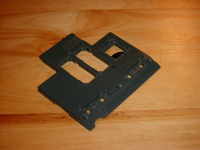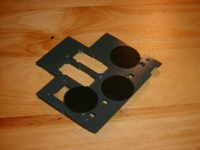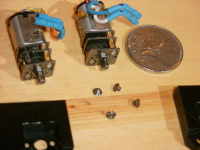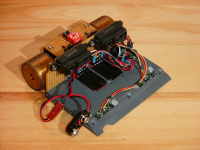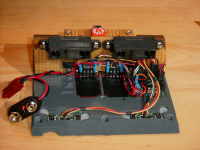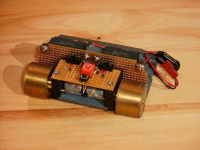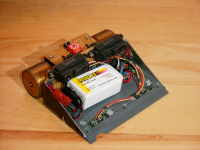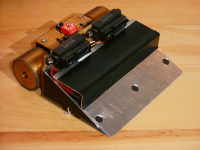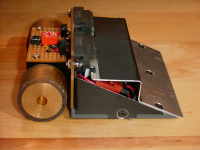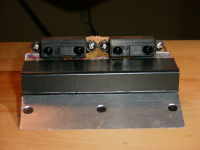Stinger
|
|
Stinger is my first attempt at building a low profile mini-sumo. I would say that
it was successful, as Stinger came in 2nd place at the
Western Canadian Robot Games in Calgary.
For those that are curious, I've included the
source code for Stinger. It's
basically a knock off of Marauder's code, but ported to the AVR.
|
|
|
|
Base
The Base is machined out of PVC. I happened to have some on hand and decided
to try it out. The notch in the front was a goof where I didn't have the material
clamped tightly enough during machining. The big holes in the middle are to allow
air cooling of the motor drivers and CPU board.
Bigger...
|
|
|
|
Bottom View of Base
Here's a picture of the bottom of the base. The black circles are
friction pads
from Lee Valley. They help to slow the bot down if the front of the sumo
goes over the edge of the ring. In normal operation, they don't touch the
ground, but when the front goes over the edge, they come in contact with the
ring.
Bigger...
|
|
|
|
Motors and Mounts
These are the GM-12
motors from Solarbotics, along with
the custom motor mounts that I machined. By rotating the motors 90° they could
be placed slighty closer together.
Bigger...
|
|
|
|
Motor Mounting Screws
These are tiny little metric screws (M1.7 x 0.35). I found some flathead ones
from Spaenaur. They were pretty pricey and
I had to buy 100. If anybody wants some, I'll sell them for $0.25 Canadian each.
That basically just covers my cost to purchase them. I threw a quarter in the
picture for scale.
Bigger...
|
|
|
|
|
|
|
Electronics
Here's all of the elecronics mounted. I'm using a
MegaBitty which has
an Atmel Mega-8 on it. I didn't install the H-Bridges that came with the MegaBitty
and wired up the Solabotics Motor Drivers instead. The line sensor boards are
MegeBitty Nano Line Sensor Boards.
There are two slide switches, one for CPU power, and one for motor power.
The orange rotary switch is a 10 position switch that I use to alter the starting behaviour.
The black pushbutton is used for starting.
Bigger...
|
|
|
|
Front view of Electronics
Another view of the electronics. I removed the JST connectors from the GP2D12's
and with a bit of bending 0.1" headers will fit nicely.
Bigger...
|
|
|
|
Rear View
Picture from the rear. I hate holding nuts, so I soldered the GP2D12 mounting
nuts to the back of the board.
Bigger...
|
|
|
|
Side View
Here's a side view. The wheels are machined from solid brass, with Synair
polyurethane for added traction. I used the same mold that I used to create
the magnetic wheels for Wedgy, so it will be pretty easy to use a set of
magnets instead. Even with the solid brass wheels, Stinger only weighs
385 grams.
Bigger...
|
|
|
|
Battery
This picture shows the battery position. I originally designed a pure wedge using
Lithium Polymer batteries, but they couldn't deliver ennough current, so I
switched back to NIMH and had to reshape the cover a bit. The battery is a Maha
9.6v NIMH battery that I purchased from Paul's Finest
(which is located in Canada).
Bigger...
|
|
|
|
Cover
Here's a picture with the cover on. I need to remake the cover and the sides to
make them look better, but this will do for now. I put black electrical tape
over some portions to make things harder to see. Of course, I left the front
portion of the scoop bare, so that some robots will think that they've hit the
white line and start to backup :)
Bigger...
|
|
|
|
|
|
|
|
Home
- Line Maze 2006
|
